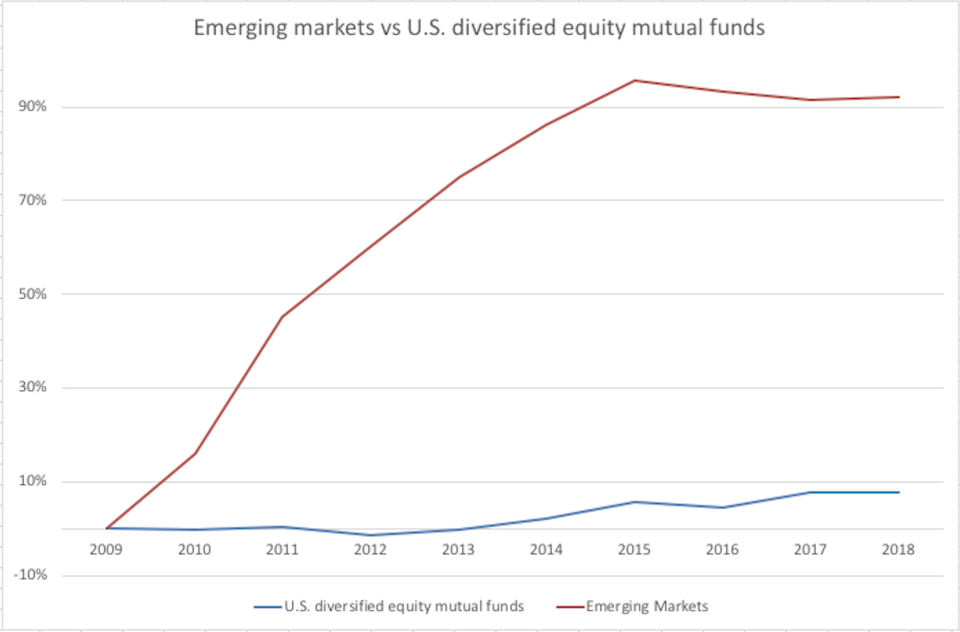Female fund managers have a much bigger presence in emerging markets than in the U.S.

When Tina Byles Williams, the chief executive and chief investment officer of FIS Group, traveled to China she was stunned, not as much by the culture or the food or the Great Wall, but by the number of women she met in financial services.
The 30-year financial veteran was shocked by the number of female presidents, CEOs, fund managers and other corporate leaders she met during her stay.
“I kept asking, ‘Well, how come there’s so many of you?’” Byles Williams recalled of her trip to China where she flew to meet with international clients.
Women have a bigger presence in Asia’s fund management business
Asia has by far the highest representation of women in asset management, comprising 32% of portfolio managers, according to the most recent study by management consulting firm Oliver Wyman. That number may not seem particularly impressive, but it’s more than double the global average.
In China, female managers run nearly a quarter (24.2%) of mutual funds, according to Chinese financial data research firm Wind Info. Just 2% of mutual funds in the United States are managed exclusively by women, according to a report by data provider Morningstar.
The presence of such a high number of women in top financial positions was understandably surprising for Byles Williams. When discussing the number of women in top positions on Wall Street, words like “abysmal,” “pathetic” and “sad” are frequent. And for good reason. Among U.S.-based firms, women represent just 10% of fund managers, Morningstar found in its most recent assessment.


The number of funds that have at least one woman as a manager is higher with U.S. equity funds and fixed income funds showing that 19.7% of funds have a female manager on the team. The problem is those numbers haven’t moved in 15 years.
Morningstar’s data tracks back to 2003, when exactly 19.7% of U.S. equity and fixed income funds had at least one woman manager on the team.
North America has a legacy boys’ club
“It’s a legacy issue,” said Sandra Ackermann-Schaufler, emerging markets senior portfolio manager at investment firm SEI. Ackermann-Schaufler previously worked as a fund manager in Germany and noted that the situation in the Americas is also worse for women than in Europe, an observation backed by research from Oliver Wyman.
“I just think the U.S. and Canada have been two markets where the fund management industry is still a boys’ club. The boys still don’t want to let women in.”
Emerging markets have a different kind of legacy
The one place that has seen growth in the number of female fund managers is emerging market funds. The number of mutual funds with a woman as one of its managers increased from 24.8% in January 2003 to 31.3% of fund managers as recently as June 2017. Where only 10% of U.S. fund managers are women, for emerging market funds, it’s 13%, Morningstar data shows.

Byles Williams surmises that the large number of women running emerging markets (EM) funds has much to do with the legacy issue.
“[Emerging markets] weren’t considered serious,” she said. “If you wanted to be a real player on Wall Street, running an emerging markets fund [or other specialized fund] would not have been a natural career path.”
Emerging markets rarely make up more than 10% to 20% of assets at major American financial firms. The thinking goes, said one fund manager who asked not to be named because of the sensitive nature of the subject, “EM isn’t a big money item, so give that to the junior people, the ladies.”
Fund management is a newer industry in China and much of Asia, and as such has a skills shortage, which creates more opportunities for women to move forward in their careers, surveys from Chinese newspaper China Daily found. The industry also lacks much of the legacy prestige it has in the United States, creating fewer barriers of entry for women.
On the other hand, relegating women to supposedly less prestigious positions has opened up opportunities in a growing market that is becoming more important and generating sizeable returns.
Emerging markets funds returned 35.2% in 2017 compared to 19.8% returns for U.S. diversified equity funds, according to data from Thomson Reuters Lipper analyzed by Yahoo Finance. EM has underperformed U.S. diversified equities over the past decade, though, returning an average of 14.89% vs. 17.08% since 2009. But that also creates an opportunity for active managers to set themselves apart from competition.
“Women are starting to recognize where there’s growth for them and where there’s not,” said Jeanne Branthover, managing partner at recruitment firm DHR International “EM is an area that is different; it’s an area that is changing and making changes in the broader landscape and growing.”

Today the number of actively managed emerging market funds has grown at more than double the pace of U.S. equity and fixed income funds. Data from Lipper found that since 2009 the number of EM funds has increased by 92%, while the number of U.S. equity funds has risen just 7.6% and the number of taxable fixed income funds increased by 33.6%.
“Women are getting very smart as to opportunity and where it is,” Branthover said.
—
Dion Rabouin is a markets reporter for Yahoo Finance. Follow him on Twitter: @DionRabouin.
Follow Yahoo Finance on Facebook, Twitter, Instagram, and LinkedIn.
